 |
| HAWKER HUNTER T.8C WT722 - '878' |
| WT722's service history
WT722 was built at Kingston-upon-Thames by Hawker Aircraft Ltd, as part of a contract to built 85 Hunter F.4 aeroplanes for the Royal Air Force. It took its first flight on 4th February 1955, flown by Hugh Merewether, and it was handed over to its new owners three months later. The aeroplane was initially issued to RAF 54(F) Sqn at RAF Odiham, and also later saw service with RAF 26(F) Sqn based at RAF Oldenburg in West Germany as aeroplane 'S'. It was returned to the UK during May 1957, as it arrived at 5MU (Maintenance Unit) Kemble for maintenance and storage. WT722 was selected for conversion to T.8 specification, and the Royal Navy contracted Hawker Aircraft Ltd to carry out the work, who in turn sub-contracted this process to Armstrong-Whitworth at Coventry. WT722 was completed as a two seat Hunter in the summer of 1959, arriving at RNAS Lossiemouth on 1st July. On 2nd December 1969 WT722 was ferried to 5MU for maintenance and storage, but within six months it had been
moved to RNAS Yeovilton where it was issued to the Air Direction Training Unit (ADTU) as aeroplane '742'. Its paint was refinished at the end of 1970, returning to ADTU service in February 1971, and was also later fitted with a Harley light at RNAS Lee-on-Solent during May 1972. On 2nd September 1982, WT722 returned as '878', an identity it would keep for the remainder of its FRADU career. A major airframe inspection, carried out by Lovaux at Hurn (now Bournemouth Airport) occurred between April and October 1986, where it received its dark sea grey paint re-finish which was gradually being adopted throughout the Hunter fleet. The aeroplane was placed in store at RAF Shawbury for 15 months (September 1990-December 1991) and was given a thorough overhaul by FLS Aerospace/Lovaux at Hurn between February 1992 and March 1993, which assured its long-term future as a flying aeroplane with FRADU. |
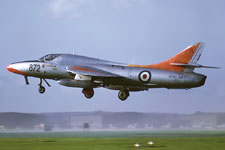 [Richard Vandervord] 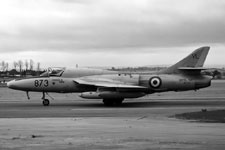 [© Eric Tammer] 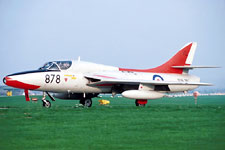 [© Martin Morley] | ||
|
|||
| | |||
WT722's civilian life Entered into the July 1995 Phillips auction by the MoD, WT722 was hammered down to Barry Pover and Barry Pearson. Barry Pover and engineers of his Classic Jet Aircraft Company prepared the aeroplane for a one-off ferry flight to Exeter Airport, arriving there in February 1996 under the civilian registration of G-BWGN. The aeroplane received a full permit to fly but was only flown occasionally for the next two years, and was placed in store in 1998. Ownership of the aeroplane was transferred outright to Barry Pearson, and over the next few years a share scheme was advertised to get the aeroplane restored to flying again. Restoration work was begun at Exeter, but progress was slow due to other projects taking priority (See XF300 and WV256) the aeroplane was later placed in store. During 2006, WT722 was moved by road to Kemble where it was placed under the care of Delta Jets. Air Atlantique now owns the aeroplane and Delta Jets began a restoration programme on its behalf during the summer of 2007 to restore WT722 to flying condition, but progress eventually ground to a halt. During May 2010, it was moved to Coventry Airport by Historic Aero Services, where it was placed on display as a static exhibit in the new Airbase museum formed by Air Atlantique/Classic Flight. Prospects of it flying again were then suspended following the cancellation of its civilian registration by the Civil Aviation Authority (CAA) in March 2011. During 2012, it was announced that the Airbase collection would move to the former RAF St Mawgan airfield in Cornwall
and become a Museum housing both static and airworthy aircraft. The airframe is now on display, and is a fine representative of the Hawker Hunter's career in Fleet Air Arm service, - December 2020 Links |
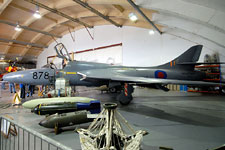 [© Gareth Horne] 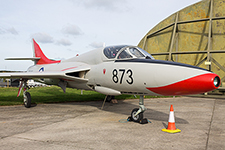 [© Kai Greet] | ||
| | |||
| << Previous airframe | Next airframe >> |